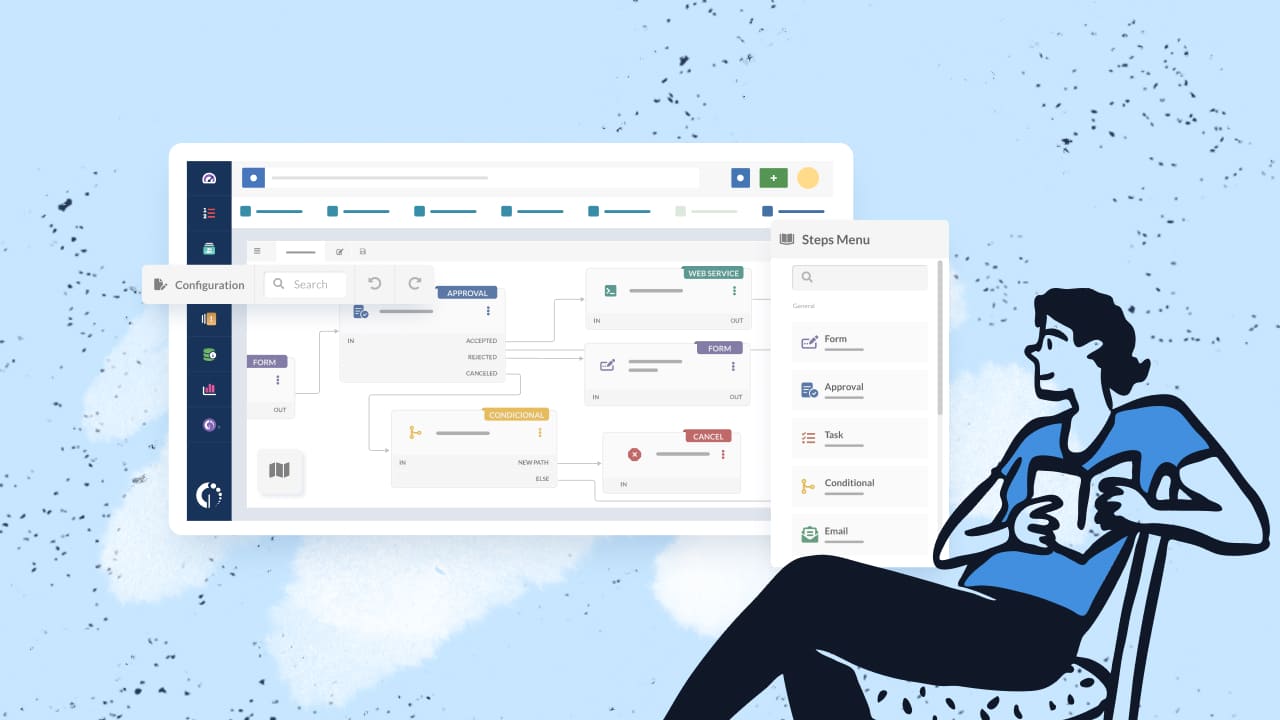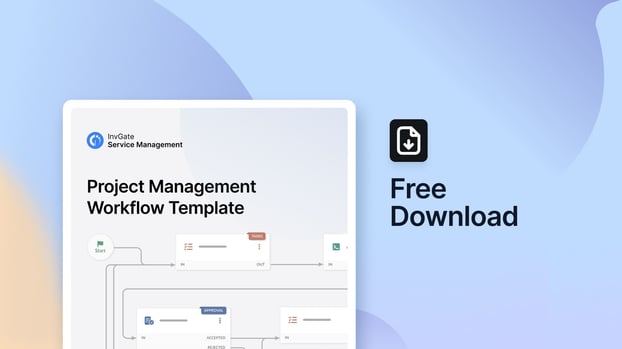A well-defined Project Management process helps IT teams keep their projects on track, ensuring that objectives are met, resources are efficiently allocated, and any potential risks are mitigated.
Managing projects effectively is crucial for any organization, especially in IT Service Management (ITSM), where delivering services in a timely and cost-effectively is vital. However, without a structured approach, projects can quickly become disorganized, leading to missed deadlines, scope creep, and unnecessary expenses.
This is where a proper Project Management workflow comes into play. By breaking down projects into specific, manageable steps, teams can focus on executing tasks efficiently while maintaining accountability and transparency.
In this post, we'll explore what the Project Management plan is, the advantages of using a predefined template, and how InvGate Service Management’s no-code workflow builder can help you design and implement your own tailored process. We’ll also offer a free downloadable workflow template to simplify the setup and help your organization benefit from a more structured approach to managing IT projects.
Ready? Let’s go!
What is Project Management?
Project Management is the process of planning, executing, and finalizing tasks that meet specific goals and objectives within a specified timeline and budget. It’s a structured framework that ensures projects move forward methodically, from inception to completion, with clear milestones and deliverables.
In the context of IT Service Management, Project Management plays an essential role in making sure IT services align with the broader business objectives. It helps IT teams manage changes, improve service delivery, and ensure that all stakeholders are aligned throughout the project's lifecycle.
Without an established Project Management strategy, teams might struggle with communication breakdowns, unclear responsibilities, and delays in execution. Ultimately, having a Project Management plan and process minimizes risks, improves project delivery, and boosts overall efficiency.
What is a Project Management workflow?
A Project Management workflow is a series of steps or phases that guide a project from the planning stage to its final completion. It acts as a blueprint that outlines all the necessary actions, approvals, and dependencies required to move a project from start to finish.
The purpose of this workflow is to make sure that each team member knows what needs to be done, when it needs to be done, and who is responsible for each task.
To help you kick things off, we’re offering a free Project Management workflow template built into InvGate Service Management. This template is crafted to simplify team coordination and keep projects on track, ensuring tasks are completed on time and meet all necessary requirements.
It includes crucial steps such as defining project goals, assigning responsibilities, tracking progress, and conducting final evaluations. By using this workflow, you’ll have a structured approach to managing project phases, from initiation to delivery, with smoother collaboration and fewer hiccups along the way.
Leverage this workflow to maintain order and efficiency throughout your project’s lifecycle, guiding each stage from the planning phase to final execution. And just so you know, while the template covers the basics, it’s fully customizable to adapt to the specific needs of your team and project goals.

Benefits of using a Project Management sample
When it comes to managing IT projects, using a Project Management template can dramatically improve both efficiency and accuracy. A template provides a standardized approach, allowing your team to follow a consistent process every time, which helps in minimizing errors and ensuring that the project is completed on time and within budget.
1. Standardization and consistency
A major benefit of using a Project Management sample is the consistency it introduces to your workflow. Instead of reinventing the wheel for every project, your team can follow a pre-established set of steps, ensuring that nothing gets overlooked.
This reduces the learning curve for new team members and ensures that all stakeholders understand the process, which, in turn, minimizes the risk of miscommunication.
By having a consistent structure in place, each project follows the same sequence, which improves efficiency. Every team member knows exactly what is expected of them, and this predictability enhances coordination among the team.
Furthermore, using a template enables you to set specific milestones and deliverables, making it easier to measure progress and adjust plans when necessary.
2. Improved collaboration and accountability
A template fosters collaboration by clearly defining the roles and responsibilities of each team member. When every step is mapped out, and tasks are allocated properly, it becomes easier for everyone to work together toward a common goal. Team members can focus on their individual tasks while remaining aware of the project's broader objectives, ensuring better teamwork and synchronization.
Moreover, the clear assignment of tasks creates a greater sense of accountability. Each team member is aware of their responsibilities and can be held accountable for their work. This reduces the likelihood of bottlenecks and delays, as everyone is more likely to meet their deadlines when they know their contributions are critical to the project's success.
3. Time and resource efficiency
Another key advantage of using a Project Management template is the time it saves. Instead of starting from scratch with every new project, you can quickly adapt the sample to suit the specific needs of your current project. This not only shortens the planning phase but also frees up valuable time that can be spent on executing tasks.
Additionally, templates help optimize the use of resources. By following a structured plan, teams can avoid over-committing to tasks or exceeding budgetary limits. Proper resource allocation is one of the main factors that contribute to successful project delivery, and templates make it easier to manage these resources efficiently.
Recommended reading: blog.invgate.com/phases-of-project-management.

How InvGate Service Management’s no-code workflow builder can help
InvGate Service Management offers a powerful no-code workflow builder that allows users to create custom workflows tailored to their specific Project Management needs. Whether you're managing IT projects, implementing new software solutions, or conducting system upgrades, this feature can help streamline the entire process.
The workflow builder is incredibly user-friendly, allowing anyone — regardless of technical background — to design workflows with ease. Through a simple drag-and-drop interface, you can customize each step of your Project Management strategy, from task creation and meeting scheduling to automated approvals and final project sign-offs. Once the workflow is set, it can be replicated and adjusted for any future projects, saving time and ensuring consistency.
Automation is another key benefit. With InvGate Service Management, you can automate repetitive tasks, such as sending notifications or updating project status, making it easier for teams to focus on higher-level activities. You can also integrate your project workflows with other ITSM processes, ensuring that your entire IT environment is managed holistically.
Download your free Project Management workflow template
If you want to streamline your Project Management processes, InvGate Service Management offers a free downloadable Project Management workflow template that can be customized to fit your organization’s needs.
This template is designed to work seamlessly within the InvGate platform, providing a structured framework to get your Project Management efforts off the ground quickly.
Once downloaded, you can adjust the Project Management plan template to match your unique requirements. The template includes pre-built stages, helping you implement a best-practice approach to managing your projects. This enables you to minimize errors, save time, and improve overall project outcomes.
Build your Project Management workflow
Designing your own Project Management workflow in InvGate Service Management is a straightforward process. By following these project methodology phases, you can create a workflow that aligns perfectly with your project objectives, timelines, and team dynamics.
Below is a step-by-step guide to help you understand and implement a comprehensive Project Management process within InvGate Service Management.
- Start: An initial trigger, typically a project proposal or a new project request.
- Plan tasks: The first step in the process is to plan the tasks required to complete the project. This involves breaking down the project into manageable tasks, defining deliverables, assigning responsibilities, and setting timelines.
- Schedule project team meeting: Once the tasks are planned, the next step is to schedule a project team meeting. This meeting ensures that all team members are aligned on the project.
- Plan approval: Following the Team Meeting, the project plan undergoes a formal approval process. This involves stakeholders reviewing the progress and alignment of the project against the original goals.
The approval outcomes can be:
Accepted: The project plan is on track and approved to move forward.
Rejected: The project plan does not meet the required standards and requires revisions.
Canceled: The project plan is terminated due to changing priorities or unforeseen issues. - Execute plan: With the tasks defined, the plan approved, and the team aligned, the project enters the execution phase. During this step, team members carry out their assigned tasks according to the project plan and timeline.
- Schedule project review meeting: Once the plan is approved, a project review meeting is scheduled to evaluate overall progress and address any challenges or risks.
- Final approval: After reviewing the project status, a final approval is required to confirm that the project is ready to proceed toward completion.
Approval outcomes include:
Accepted: The project is approved to move toward finalization.
Rejected: The project needs adjustments and will return to a previous stage for further refinement.
Canceled: The project is discontinued due to misalignment or other factors. - Email - Project finished: The final step in the process is to notify stakeholders that the project is completed. An automated email or formal communication is sent to all relevant parties, marking the official closure of the project.
Key takeaways
A well-designed Project Management process is crucial to the success of any IT initiative. By using a structured workflow, teams can ensure that projects are completed on time, within budget, and meet all specified goals.
InvGate Service Management offers an easy, intuitive way to design and implement these workflows, helping teams optimize their Project Management processes. With clear task assignments, automatic approvals, and real-time progress tracking, you can ensure that your team stays aligned and focused on delivering successful IT projects. Experience it firsthand! Start your 30-day free trial today and explore the tool at your own pace.
Frequently Asked Questions
1. What is the importance of Project Management in ITSM?
Project Management in ITSM helps ensure that IT-related projects are delivered on time, within budget, and according to business objectives. This structured approach improves accountability, reduces risks, and ensures that IT services align with organizational goals.
2. How can I customize my Project Management process using InvGate Service Management?
InvGate Service Management offers a no-code workflow builder that allows you to design custom Project Management workflows. You can easily create, modify, and automate workflows by dragging and dropping components, without requiring programming knowledge.
3. What are the benefits of using a Project Management template?
A Project Management template provides consistency, accountability, and transparency across all projects. It saves time by eliminating the need to start from scratch and reduces the risk of mismanagement by providing a structured process.
4. Can I automate the Project Management process?
Yes, InvGate Service Management allows you to automate various stages of the Project Management process. You can set triggers that automatically move the project to the next phase once tasks are completed, streamlining the workflow and ensuring faster project completion.















